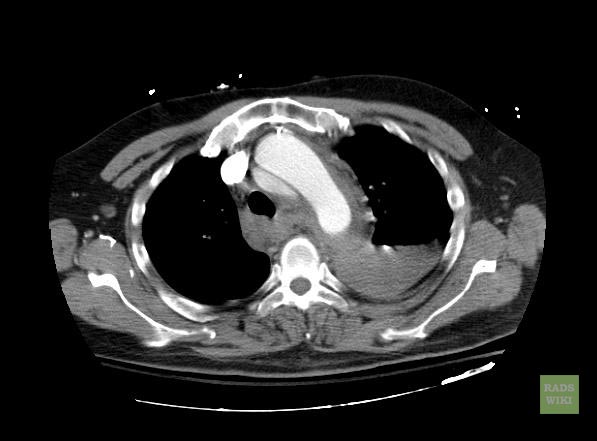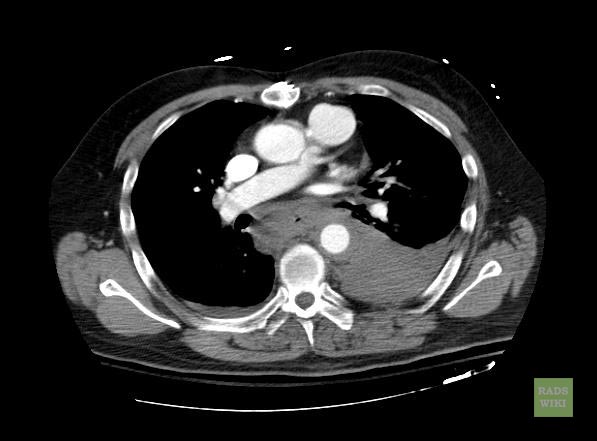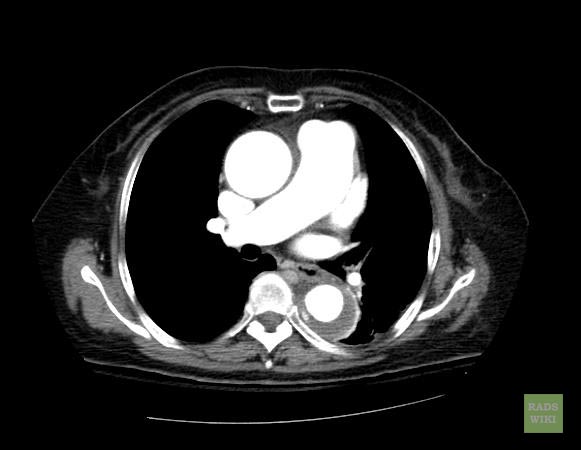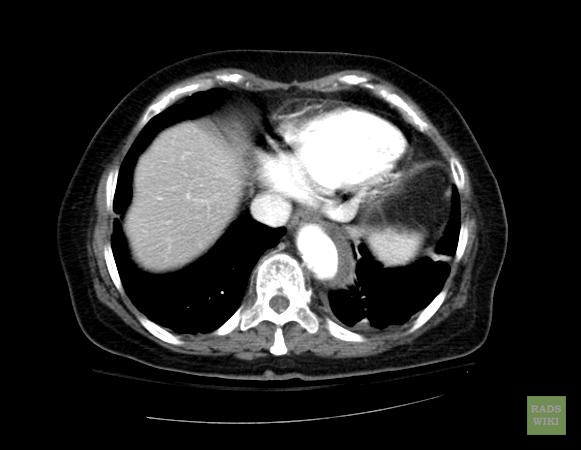Aortic intramural hematoma: Difference between revisions
Jump to navigation
Jump to search
Devesh Rai (talk | contribs) |
Devesh Rai (talk | contribs) |
||
| Line 87: | Line 87: | ||
=== Symptoms === | === Symptoms === | ||
*Symptoms of IMH may include the following: | *Symptoms of IMH may include the following:<ref name="pmid15020502">{{cite journal| author=Song JK| title=Diagnosis of aortic intramural haematoma. | journal=Heart | year= 2004 | volume= 90 | issue= 4 | pages= 368-71 | pmid=15020502 | doi= | pmc=1768152 | url=https://www.ncbi.nlm.nih.gov/entrez/eutils/elink.fcgi?dbfrom=pubmed&tool=sumsearch.org/cite&retmode=ref&cmd=prlinks&id=15020502 }} </ref> | ||
:*Sudden onset chest pain | :*Sudden onset chest pain | ||
:*Back pain | :*Back pain | ||
| Line 93: | Line 93: | ||
:*Abdomen pain | :*Abdomen pain | ||
:*Sweating | :*Sweating | ||
=== Physical Examination === | === Physical Examination === | ||
*Patients with IMH usually appear distressed and it depends on the stage of their presentation. | *Patients with IMH usually appear distressed and it depends on the stage of their presentation. | ||
Revision as of 02:24, 10 April 2019
Editor-In-Chief: C. Michael Gibson, M.S., M.D. [1]
Associate Editor-In-Chief: Cafer Zorkun, M.D., Ph.D. [2]
Overview
- Aortic intramural hematoma is classically abbreviated as IMH.
- It may occur as a primary event in hypertensive patients in whom there is spontaneous bleeding from vasa vasorum into the media or may be caused by a penetrating atherosclerotic ulcer.
- Intramural hematoma may also develop as a result of blunt chest trauma with aortic wall injury.
- Thought to begin with the rupture of the vasa vasorum, the blood vessels that penetrate the outer half of the aortic media from the adventitia and arborize within the media to supply the aortic wall.
- The hematoma propagates along the media layer of the aorta.
- Consequently, intramural hematoma weakens the aorta and may progress either to outward rupture of the aortic wall or to inward disruption of the intima, the latter leading to communicating aortic dissection.
- Unlike aortic dissection, no intimal flap is present.
- If it involves the ascending aorta, treatment is surgical to prevent rupture or progression to a classic aortic dissection.
- Conservative management is indicated for aortic intramural hematomas of the descending aorta.
Historical Perspective
- The diagnosis of aortic intramural hematoma dates back to early 1980s when the choice of diagnosis was Trans-esophageal echocardiography.[1]
Classification
- IMH is classified into two types on the basis of Standford classification.[2]
- Type A IMH: involves the ascending aorta, and may or may not involve descending aorta
- Type B IMH: involves the descending aorta only distal to left subclavian artery
Pathophysiology
- The pathogenesis of IMH is characterized by either rupture of vasa vasorum or tea in the intimal layer.
- Rupture of vasa vasorum is seen in the majority of cases, which separates medial wall of the aorta leading to a tear but there is no continuous flow. The hematoma is contained within the wall.[3]
- Small microscopic tear in the penetrating aortic ulcer is another mechanism leading to formation of IMH. These ulcers are mostly associated with atherosclerotic changes of the aortic wall as well.[3]
- On microscopic histopathological analysis, hematoma is seen in the media layer of the aorta.
Clinical Features
Pain is the most common presentation of patients with IMH. The location of pain depends on the location of IMH.
Chest pain is the most common presenting symptoms in 82.5 % of the patients, followed by back pain (41%), abdominal pain (13.1%).[3]
Pain is reportedly severe on onset in almost all the cases, abrupt in onset. Radiation of pain is seen 45.9% of patients.
Upto 32% of these patients can present with hypertension, whereas a minority(11.9%) present with hypotension.
Patient with Type A IMH can present with murmur of aortic regurgitation (35.2%) and pulse deficit is seen in a minority(15.1%) of the patients.
Differentiating Aortic Intramural Hematoma from other Diseases
- IMH must be differentiated from other diseases that cause sudden onset chest pain, back pain, abdomen pain with or without radiation such as:
- Aortic Dissection
- Acute Coronary Syndrome
- Pulmonary Embolism
- Renal Infarct
- Mesenetric ischemia
- Trauma to the back
Epidemiology and Demographics
- The prevalence of IMH is approximately 2 to 4 cases per 100,000 individuals worldwide.[4]
Age
- IMH is more commonly observed among patients age in the range of 60-80 years old.
- Mean age for presentation is 69 years.[5]
Gender
- IMH is more common in men with 50-81% of cases occuring commonly in men.[5]
Race
- There is no racial predilection for IMH.[5]
Risk Factors
- Common risk factors in the development of IMH are hypertension, smoking, connective tissue disorder (Marfan's syndrome, Loeys-Sietz syndrome), bicuspid aortic valve, prior aortic surgery, aortic aneurysm and atherosclerosis.[6]
Natural History, Complications and Prognosis
- IMH resolve spontaneously in about 10% of patients.[7]
- Early clinical features include sudden onset chest pain, back pain and hypertensive emergency.
- If left untreated, 16-47% of patients with IMH may progress to develop aortic dissection which can be life threatening.[8]
- Common complications of IMH include progression to aortic dissection, formation of periaortic hematoma, pericardial effusion, pericardial tamponade, pseudoaneurysm, and aortic regurgitation.[9]
- Prognosis is generally poor, and depends on multitude of factors like location of IMH, presentation, mode of management (medical vs surgical)
Diagnosis
Diagnostic Criteria
- The diagnosis of IMH is made with clinical examination in combination of radiological or echocardiographic findings. Although, there is no specific diagnostic criteria set for IMH. A study has suggested mean thickness of Type A IMH was in the range of 5-40 mm, and type B IMH was reported in the range of 5-23 mm.[10]
Symptoms
- Symptoms of IMH may include the following:[10]
- Sudden onset chest pain
- Back pain
- Radiation of pain from chest to back
- Abdomen pain
- Sweating
Physical Examination
- Patients with IMH usually appear distressed and it depends on the stage of their presentation.
- Physical examination may be remarkable for:
- Sweating
- Tachycardia
- Hypertension
- Aortic Regurgitation murmur
- Radial-radial pulse deficit or Radial-femoral pulse deficit depending on the location of the IMH
Laboratory Findings
- There are no specific laboratory findings associated with IMH.
- Occasionally, a drop in hemoglobin or hematocrit can be seen in patients where IMH is progressing to aortic dissection.
Imaging Findings
- There are no [imaging study] findings associated with [disease name].
- [Imaging study 1] is the imaging modality of choice for [disease name].
- On [imaging study 1], [disease name] is characterized by [finding 1], [finding 2], and [finding 3].
- [Imaging study 2] may demonstrate [finding 1], [finding 2], and [finding 3].
Other Diagnostic Studies
- [Disease name] may also be diagnosed using [diagnostic study name].
- Findings on [diagnostic study name] include [finding 1], [finding 2], and [finding 3].
Treatment
Medical Therapy
- There is no treatment for [disease name]; the mainstay of therapy is supportive care.
- The mainstay of therapy for [disease name] is [medical therapy 1] and [medical therapy 2].
- [Medical therapy 1] acts by [mechanism of action 1].
- Response to [medical therapy 1] can be monitored with [test/physical finding/imaging] every [frequency/duration].
Surgery
- Surgery is the mainstay of therapy for [disease name].
- [Surgical procedure] in conjunction with [chemotherapy/radiation] is the most common approach to the treatment of [disease name].
- [Surgical procedure] can only be performed for patients with [disease stage] [disease name].
Prevention
- There are no primary preventive measures available for [disease name].
- Effective measures for the primary prevention of [disease name] include [measure1], [measure2], and [measure3].
- Once diagnosed and successfully treated, patients with [disease name] are followed-up every [duration]. Follow-up testing includes [test 1], [test 2], and [test 3].
Examples






- Macura, Katarzyna J., Corl, Frank M., Fishman, Elliot K., Bluemke, David A. Pathogenesis in Acute Aortic Syndromes: Aortic Dissection, Intramural Hematoma, and Penetrating Atherosclerotic Aortic Ulcer. Am. J. Roentgenol. 2003 181: 309-316.
- Gomez-Jorge, Jackeline. E-medicine rads article
See also
External Links
References
- ↑ Vilacosta I, San Román JA, Ferreirós J, Aragoncillo P, Méndez R, Castillo JA; et al. (1997). "Natural history and serial morphology of aortic intramural hematoma: a novel variant of aortic dissection". Am Heart J. 134 (3): 495–507. PMID 9327708.
- ↑ Lempel JK, Frazier AA, Jeudy J, Kligerman SJ, Schultz R, Ninalowo HA; et al. (2014). "Aortic arch dissection: a controversy of classification". Radiology. 271 (3): 848–55. doi:10.1148/radiol.14131457. PMID 24617732.
- ↑ 3.0 3.1 3.2 Alomari IB, Hamirani YS, Madera G, Tabe C, Akhtar N, Raizada V (2014). "Aortic intramural hematoma and its complications". Circulation. 129 (6): 711–6. doi:10.1161/CIRCULATIONAHA.113.001809. PMID 24515957.
- ↑ Larson EW, Edwards WD (1984). "Risk factors for aortic dissection: a necropsy study of 161 cases". Am J Cardiol. 53 (6): 849–55. PMID 6702637.
- ↑ 5.0 5.1 5.2 Mussa FF, Horton JD, Moridzadeh R, Nicholson J, Trimarchi S, Eagle KA (2016). "Acute Aortic Dissection and Intramural Hematoma: A Systematic Review". JAMA. 316 (7): 754–63. doi:10.1001/jama.2016.10026. PMID 27533160.
- ↑ Hagan PG, Nienaber CA, Isselbacher EM, Bruckman D, Karavite DJ, Russman PL; et al. (2000). "The International Registry of Acute Aortic Dissection (IRAD): new insights into an old disease". JAMA. 283 (7): 897–903. PMID 10685714.
- ↑ Braverman AC (2010). "Acute aortic dissection: clinician update". Circulation. 122 (2): 184–8. doi:10.1161/CIRCULATIONAHA.110.958975. PMID 20625143.
- ↑ Nienaber CA, Sievers HH (2002). "Intramural hematoma in acute aortic syndrome: more than one variant of dissection?". Circulation. 106 (3): 284–5. PMID 12119238.
- ↑ Ganaha F, Miller DC, Sugimoto K, Do YS, Minamiguchi H, Saito H; et al. (2002). "Prognosis of aortic intramural hematoma with and without penetrating atherosclerotic ulcer: a clinical and radiological analysis". Circulation. 106 (3): 342–8. PMID 12119251.
- ↑ 10.0 10.1 Song JK (2004). "Diagnosis of aortic intramural haematoma". Heart. 90 (4): 368–71. PMC 1768152. PMID 15020502.